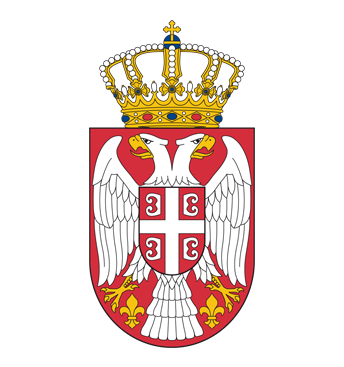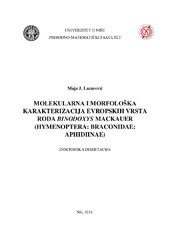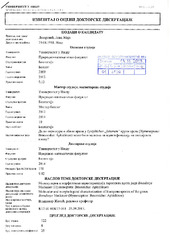Приказ основних података о дисертацији
Molekularna i morfološka karakterizacija evropskih vrsta roda Binodoxys Mackauer (Hymenoptera: Bracondiae: Aphidiinae)
| dc.contributor.advisor | Tomanović, Željko | |
| dc.contributor.other | Ilić-Milošević, Marijana | |
| dc.contributor.other | Stanković, Saša | |
| dc.creator | Lazarević, Maja | |
| dc.date.accessioned | 2020-08-06T11:14:54Z | |
| dc.date.available | 2020-08-06T11:14:54Z | |
| dc.date.issued | 2020-02-07 | |
| dc.identifier.uri | http://eteze.ni.ac.rs/application/showtheses?thesesId=7458 | |
| dc.identifier.uri | https://fedorani.ni.ac.rs/fedora/get/o:1649/bdef:Content/download | |
| dc.identifier.uri | http://vbs.rs/scripts/cobiss?command=DISPLAY&base=70052&RID=534217366 | |
| dc.identifier.uri | https://nardus.mpn.gov.rs/handle/123456789/17312 | |
| dc.description | The genera Binodoxys assembles 70 species of Holarctic distribution. Based on the presence of secondary tubercles on the second metasomal segment (petiole), genera Binodoxys can be discriminated from the Trioxys species. The position of the primary and secondary tubercles is taxonomic character for the separation of Binodoxys species. Based on the morphology of the petiole and other morphological characters, eight species have been described in European fauna. The main objective of this study is to determent the molecular and morphological differences between the six European species. Morphologically, using the geometric morphomterics method, 111 petioles and 175 forewings of females were analysed. Molecular analysis was applied using the barcoding COI gene. The geometric morphometrics method of petioles showed the existence of two morpho-groups: „angelicae“ (B. angelicae и B. centaureae) and „acalephae“ (B. acalephae, B. brevicornis, B. heraclei и B. similis). Species from the „angelicae“ morpho-group have elongated petioles long distance between the primary and secondary tubercles, while the petioles of “acalephae” morpho-group are short and with smaller intertubercular distance. The geometric morphometrics of forewings, showed that the B. similis has similar wing morphology to that in “angelicae” morpho-group. Forewings of “angelicae” morpho-group were narrowed, and with longer radial sector vein, when compared to the members of “acalephae” group. Molecular analysis confirmed the existence of six species, which are discriminated in two phylogenetic clades. The first clade clusters two species (B. angelicae and B. centaureae), while the remaining four species are grouped in the second lineage (B. acalephae + (B. heraclei + (B. brevicornis + B. similis))). Mapping the phylogeny over the morphological data showed that phylogenetically closer species have a similar petiole shape, but not forewings. Scanning electron microscopy revealed differences in shape and size of the heads and ovipositor. Members of “angelicae” phylo-morpho-group have long petioles and heads, but short ovipositors. Based on all the analyses applied, the existence of six Binodxys species classified into two phylo-morpho groups was confirmed. | en |
| dc.format | application/pdf | |
| dc.language | sr | |
| dc.publisher | Универзитет у Нишу, Природно-математички факултет | sr |
| dc.relation | info:eu-repo/grantAgreement/MESTD/Integrated and Interdisciplinary Research (IIR or III)/43001/RS// | |
| dc.rights | openAccess | en |
| dc.rights.uri | https://creativecommons.org/licenses/by-nc-nd/4.0/ | |
| dc.source | Универзитет у Нишу | sr |
| dc.subject | Binodoxys | sr |
| dc.subject | Binodoxys | en |
| dc.subject | the geometric morphometrics | en |
| dc.subject | petioles | en |
| dc.subject | wings | en |
| dc.subject | COI | en |
| dc.subject | SEM | en |
| dc.subject | геометријска морофметрија | sr |
| dc.subject | петиолуси | sr |
| dc.subject | крила | sr |
| dc.subject | COI ген | sr |
| dc.subject | SEM | sr |
| dc.title | Molekularna i morfološka karakterizacija evropskih vrsta roda Binodoxys Mackauer (Hymenoptera: Bracondiae: Aphidiinae) | sr |
| dc.type | doctoralThesis | en |
| dc.rights.license | BY-NC-ND | |
| dc.identifier.fulltext | https://nardus.mpn.gov.rs/bitstream/id/64429/Disertacija.pdf | |
| dc.identifier.fulltext | https://nardus.mpn.gov.rs/bitstream/id/64430/Lazarevic_Maja_J.pdf | |
| dc.identifier.rcub | https://hdl.handle.net/21.15107/rcub_nardus_17312 |



